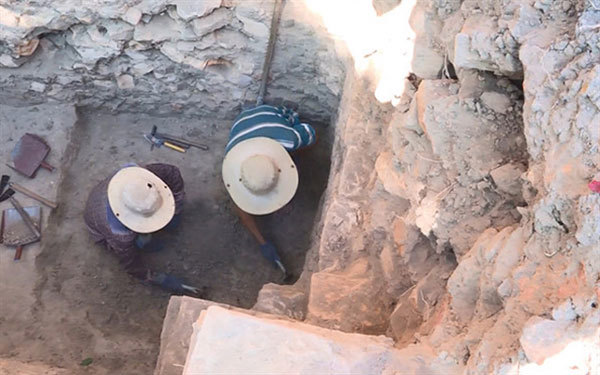Champa culture antiques uncovered in Phu Yen province
The most famous Cham towers in Vietnam
 |
| Workers at the Dong Mieu Cham tower site in Phu Hoa District, Phu Yen Province. – Photo truyenhinhdulich.vn |
Researcher Nguyen Tien Dong, head of the Urban Archaeology Department of the Viet Nam Archaeology Institute, said Dong Mieu relic site is located near the upper region of the Ba River, 10km from Tuy Hoa City and 2km from Ho Citadel, the ancient administration centre of the Chăm Pa Kingdom.
Today, the site is in Phu Hoa Town, Phu Hoa District, Phu Yen Province.
Archaeologists excavated the site and unearthed the foundation and body of a temple, or Cham tower, which collapsed long ago.
“We found traces of a bridge and a dam, which might have been a product of the Cham Pa Kingdom,” Dong said. “We found broken pieces of Cham ceramic art with square decoration patterns.”
Dong said the tower is small for its kind but was built mostly out of bricks rather than stones.
The tower was rebuilt once.
“What makes the tower different from other Cham towers is that ancient Cham people used a kind of vegetable oil, maybe 'dầu rái' in local language, and mingled it with some substance to create a mixture," he said. "They put the mixture on to the bricks to make the bricks stick into one another.
“This finding rejects the earlier assumption that there was no glue between bricks in Cham architecture.
“The glue layer is very thin and scientists have not noticed it before,” he said.
Dong said that based on different types of bricks and materials found at the tower, archaeologists guessed the tower was first built in the fourth century and then rebuilt in the fifth century.
“This is the earliest remnant of a Cham Pa brick tower found so far,” he said. “French scientists did not even know about the tower. Before this, scholars of Cham architecture thought Cham Pa architecture dated from the seventh century."
The late Professor Tran Quoc Vuong had sketched a map of the small Cham Pa region with a big river (perhaps Ba River in Phu Yen) as the main axis. From the axis, ports and urban areas developed on both sides of the river.
“Archaeologists have also found a big jar of coins, which are now kept at Phu Yen Museum,” Dong said.
He said the Dong Mieu site may have been the holy land of the small Cham Pa region.
The Cham Pa kingdom ruled in the central coastal region of Vietnam between the fourth and 13th centuries. Many towers could remain undiscovered in the area.
VNS
 Archaeologists have announced the results of recent excavations at the site of a Cham tower in the central province of Phu Yen which proved the tower was among the earliest of its kind, dating from around the fourth century.
Archaeologists have announced the results of recent excavations at the site of a Cham tower in the central province of Phu Yen which proved the tower was among the earliest of its kind, dating from around the fourth century.